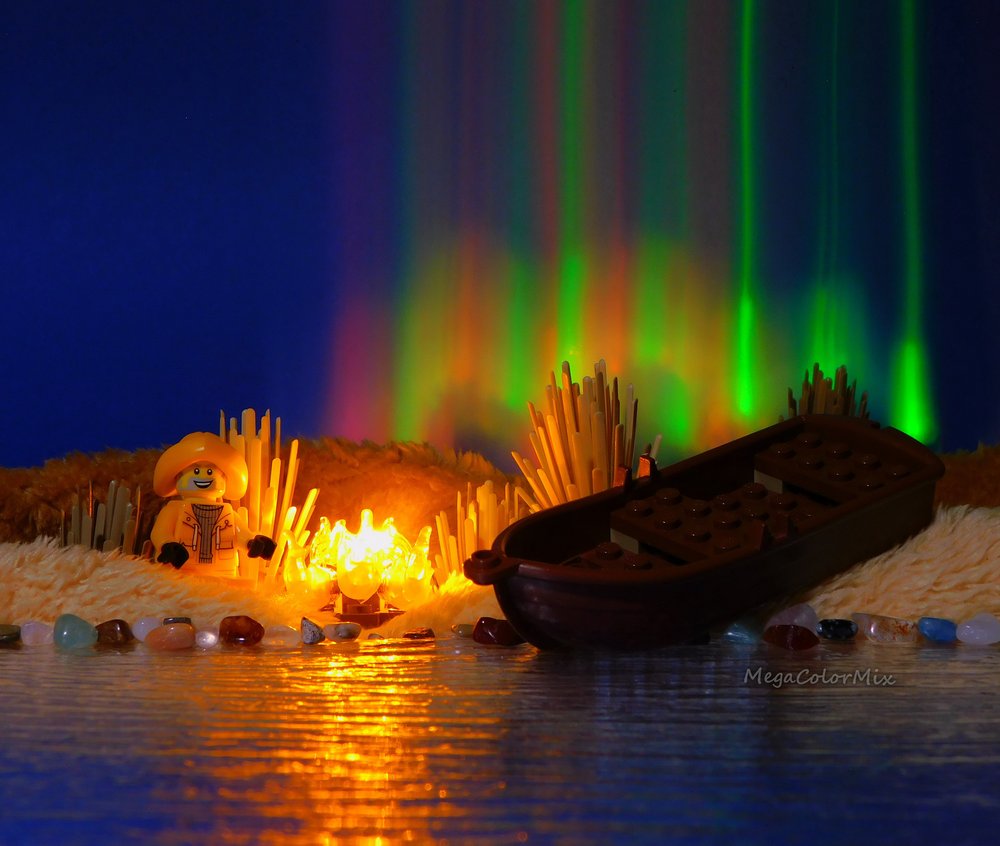Painting The Sky: Creating The Northern Lights For LEGO Photography
A special expedition awaits your LEGO characters! Today, all the Arctic researchers, fishers, hikers, and tourists of the LEGO world will become the real Aurora Hunters because we are going to visit different corners of the Earth and paint the night sky with the colors of the Northern Lights!

The Aurora Borealis, better known as the Northern Lights, is an optical phenomenon when the charged particles from the sun hit the upper atmosphere of our planet, causing a luminous display! If we “translate” it from physical attributes to artistic ones, it’s a breathtaking natural show full of pulsating shapes and colors.

Image credit here.
Today, we’re going to study its different forms, recreating them with simple lighting equipment. Let’s get started with our new light painting project under the stars!

Ribbons of Light
Formed in periods of high solar activity, these bright stripes appear in many colors depending on different elements that take part in the reaction. For example, green and blue are created with oxygen atoms.
The process of painting with light is fascinating and maximally effective with just one simple lighting element. Using a string of lights or fairy lights, roll them up in a solid “stick” in order to get more lights in one line. Then bend the group of wires into the shape of your desired auroral band, set up your camera, and then wave the light stick from the bottom up. The faster you move it, the better you make it blurred in the final photo (you can use a longer exposure but the base settings should work fine if you are fast enough).

Lines in the Sky
You can make your scene even more dynamic by using several lighting elements to create multiple bands in the sky. The scene I made below was inspired by the stunning views of Canada, known as the auroral zone which sees the Northern Lights quite often!.

The interlacing of several shining lines of lights will add movement to the picture, and make it even more spectacular. Just hold another homemade light stick under the first one, and shape it into something that echoes the first one for a harmonious effect.

Image credit here.
Columns of Light
One of the most common forms of the Northern Lights appears in red and green colors and appears as a type of light “column” spaced along the whole auroral line.


For our LEGO photography, this time we'll interlace red and green lights so that two different colors will interchange on one line. This creates a shining effect when you move the stick quickly up and down.

Image credit here.
Beads on a Necklace
If you modify this light painting method, you can achieve a new kind of Northern Lights that are considered to be very rare. These auroral patterns appear when the solar wind rolls up the external boundary of the magnetosphere of the Earth into the waves, looking like the beads on the necklace.


This global optical phenomenon can be easily recreated with the help of one tiny photographic trick. When under longer exposure, pause for a second before you start waving your lights to recreate the pulsing beads in the sky.

You can play with the background in order to match each light pattern. Experiment by changing the level of brightness or switching on or off the stars! And now let's continue our Aurora Hunting trips with more LEGO, stars and colors...
Arcs of Color
Looking at another type of Northern Lights display, Stable Auroral Red (SAR) arcs are characterized by red luminescence of the atmospheric layers, the result of electrons heating in the upper part of the ionosphere of our planet.


In our case, the SAR arcs can be created by spreading the mix of blurred green and red lights across the night sky. As you can see, it’s the second time I’ve used the LEGO light brick in this project.
However, even the new light brick seems to be too dim for the well-lit scene, so I invented my own mini-filter: this is sticky tape that comes in different colors. You can bend the piece of this material and stick the adhesive sides together to create a quick filter that was extra bright!

Image credit here.
Sweeping Dunes
This unusual and interesting form of the Nothern Lights was recently discovered in Finland and Sweden, described as green parallel stripes and looking like sand dunes. They formed because of the horizontal atmospheric wave that modulates the atomic oxygen density.


You can paint this effect in your LEGO builds by waving your green lighting stick from left to right. The lights should be on at half-power. You don’t even need to set a long exposure time because, in most cases, you will be able to paint the northern lights with the speed of the camera click.

Image credit here.
As you can see, you can recreate the gorgeous natural phenomenon of the Aurora Borealis in your LEGO photography without using any additional manual camera settings or special lighting equipment. I hope you enjoyed our magical show under the stars!
Have you ever seen the Northern Lights? Let us know in the comments below!
Do you want to help BrickNerd continue publishing articles like this one? Become a top patron like Charlie Stephens, Marc & Liz Puleo, Paige Mueller, Rob Klingberg from Brickstuff, John & Joshua Hanlon from Beyond the Brick, Megan Lum, Andy Price, Lukas Kurth from StoneWars, Wayne Tyler, Monica Innis, Dan Church, and Roxanne Baxter to show your support, get early access, exclusive swag and more.

